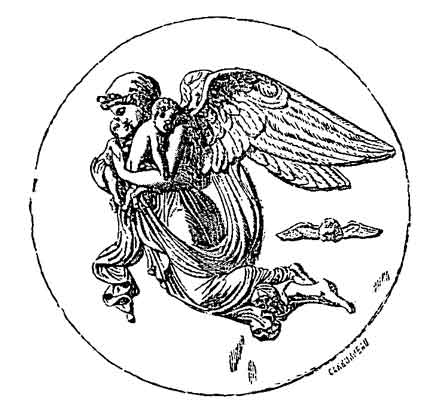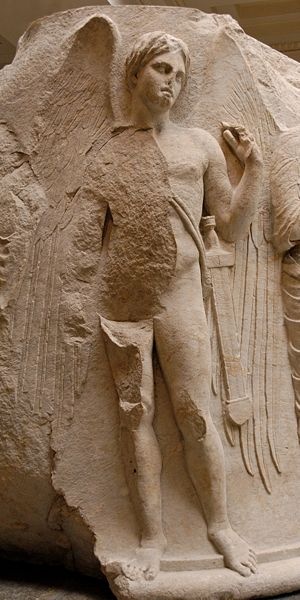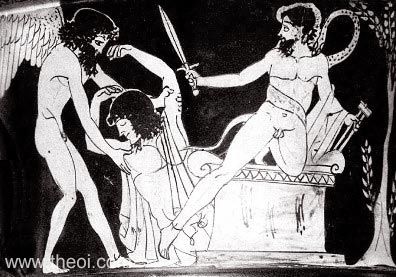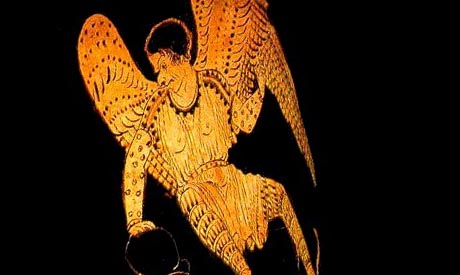You are currently browsing the tag archive for the ‘Nyx’ tag.
In ancient Greece, there were two incarnations of death. The more well-known Greek personification of Death was Thanatos, the child of Nyx and brother of Hypnos (Sleep). Thanatos represented natural death and was portrayed as a gentle being. He was represented either as a kind handsome bearded man with wings or as a beautiful winged child. Thantos is sometimes portrayed carrying a butterfly, a wreath, or an inverted torch. Thanatos is frequently represented on funerary stele and on vases—a peaceful figure who led souls away after they had lived full lives.
However Thanatos had a flock of hellish sisters, the Keres, dark flying beings with sharp teeth and an insatiable taste for blood. The Keres represented violent senseless death. They flew in the thousands above battlefields and hung over plague ravaged cities. The Keres were associated with the apparatus of violent death–famine, madness, agony, hate, and violence, yet classical authors also sometimes treat them as oddly personal—like a bullet with a soldier’s name on it. Keres were portrayed like harpies or demons—cruel women with fangs and talons dressed in bloody ripped garments. When they found a wounded or sick person the Keres would descend to feast on blood. Hesiod’s harrowing poem, The Shield of Heracles describes them in such a manner:
The black Keres, clashing their white teeth,
Grim faced, shaggy, blood-bespattered, dread,
Kept struggling for the fallen. They all wanted
To drink black blood. Whom first they caught.
Lying or fallen newkly wounded, around him
They threw their might talosns, and the shade to Hades
Went, in icy Tartarus. Their hearts were glutted
With human blood: they threw away the corpse
And back to the tumult and fighting rushed, in new desire
(verses 248-257)
Hesiod also indirectly indicates that the Keres were among the horrible fates which flew out of Pandora’s box and have subsequently plagued mankind. The Romans also believed in these cruel & deadly incarnations of fat. The Roman name for the entities was tenebrae—“darknesses”
The Keres do not fit neatly into the larger Greco-Roman pantheon. Perhaps, like Nyx herself, they were outsider gods left over from some earlier tradition. Throughout the course of classical history, their portrayal and their fatalistic meaning changed. However they were a part of classical thought. It is important to mention them when writing about the Greek underworld. The dark realm below was haunted by these cruel children of night—they would fly forth when disaster struck humankind.
 One of the most enigmatic Greek divinities is Nyx, the primordial goddess of the Night. In Hesiod’s Theogeny she was a child of Chaos, but, in other texts, Nyx was present at (or before) creation and had no parents. She is rarely mentioned in classical texts, but the few times she does appear are noteworthy. Some of her children include Death (Thanatos), Sleep (Hypnos), Mockery (Momus), Dreams (Morpheus), and the Fates (Moirae)–they represent various slantwise forces which even the Olympian gods are subject to.
One of the most enigmatic Greek divinities is Nyx, the primordial goddess of the Night. In Hesiod’s Theogeny she was a child of Chaos, but, in other texts, Nyx was present at (or before) creation and had no parents. She is rarely mentioned in classical texts, but the few times she does appear are noteworthy. Some of her children include Death (Thanatos), Sleep (Hypnos), Mockery (Momus), Dreams (Morpheus), and the Fates (Moirae)–they represent various slantwise forces which even the Olympian gods are subject to.
Nyx is mentioned in Chapter XIV of Homer’s Illiad, when the sleep god Hypnos refuses to carry out Hera’s bidding. Hypnos describes the past results of putting Zeus to sleep (against Zeus’ will) and relates how his mother saved him:
“Jove was furious when he awoke, and began hurling the gods about all over the house; he was looking more particularly for myself, and would have flung me down through space into the sea where I should never have been heard of any more, had not Night who cows both men and gods protected me. I fled to her and Jove left off looking for me in spite of his being so angry, for he did not dare do anything to displease Night. And now you are again asking me to do something on which I cannot venture.” [Forgive the Roman names—I used the Johnson translation for ease of citation and copying. Also, obviously, Nyx is called “Night” as she is in the rough Aristophanes quote below. I’ll try to find some prettier translations later.]
Nyx is also mentioned in Orphic cult poetry (certain mystery cult poems were attributed to the demigod Orpheus) where she is portrayed as a bird/woman with black wings who first created the universe. She dwells in a cave at the edge of the Cosmos. With her in the eternal darkness is Kronos, Zeus’ father, who was savagely mutilated by his son. Kronos is unconscious, drunk on magical honey, and he mutters prophecies which Nix then chants. Outside the cave is Zeus’ nursemaid, Adrasteia, who acted as mother for the king of the gods during his boyhood. Adrasteia keens and beats a cymbal to Nyx’s chanting and the entire universe subtly moves to the rhythm of her cymbal.
Aristophanes alludes to the Orphic mystery poetry in a chorus from his play “The Birds”. The chorus is sung by birds who have a different take on creation. In their interpretation, night is a bird and they are descended from her via love and chaos. Here is the relevant portion of their song:
…At the start,
was Chaos, and Night, and pitch-black Erebus,
and spacious Tartarus. There was no earth, no heaven,
no atmosphere. Then in the wide womb of Erebus,
that boundless space, black-winged Night, first creature born,
made pregnant by the wind, once laid an egg. It hatched,
when seasons came around, and out of it sprang Love—
the source of all desire, on his back the glitter
of his golden wings, just like the swirling whirlwind.
In broad Tartarus, Love had sex with murky Chaos.
From them our race was born—our first glimpse of the light
not before Love mixed all things up. But once they’d bred
and blended in with one another, Heaven was born,
Ocean and Earth—and all that clan of deathless gods.
Thus, we’re by far the oldest of all blessed ones,
for we are born from Love. There’s lots of proof for this.
We fly around the place, assisting those in love—
[Translation by Ian Johnston]
Although a few small temples and cults to Nyx existed, she was not often worshiped openly in Greece (nor, for that matter, were her children). However Nyx was in the background of many other god’s temples and ceremonies as a statue or a sacred phrase. Around her name and mythos was an impalpable shroud of ambiguity. To the Greeks, Nyx was older and stranger than the gods they cared about and worshiped–she was the first and original outsider.




